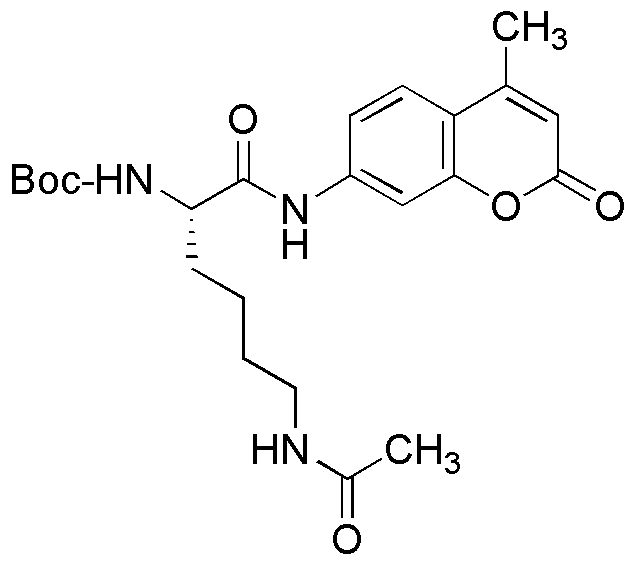Na-Boc-Ne-acetyl-L-lysine 7-amido-4-methylcoumarin is widely utilized in research focused on:
- Fluorescent Labeling: This compound is often used in bioconjugation techniques to label proteins and peptides, enabling researchers to track biological processes in real-time.
- Drug Development: It serves as a key intermediate in synthesizing novel pharmaceuticals, particularly in developing targeted therapies for various diseases.
- Biochemical Assays: The compound is employed in assays to study enzyme activity and protein interactions, providing insights into cellular mechanisms.
- Peptide Synthesis: It is used in the solid-phase synthesis of peptides, enhancing the efficiency and yield of complex peptide sequences.
- Research in Cancer Therapeutics: Its unique structure allows for the exploration of new cancer treatment options, particularly in targeting specific cancer cell types.
General Information
Properties
Safety and Regulations
Applications
Na-Boc-Ne-acetyl-L-lysine 7-amido-4-methylcoumarin is widely utilized in research focused on:
- Fluorescent Labeling: This compound is often used in bioconjugation techniques to label proteins and peptides, enabling researchers to track biological processes in real-time.
- Drug Development: It serves as a key intermediate in synthesizing novel pharmaceuticals, particularly in developing targeted therapies for various diseases.
- Biochemical Assays: The compound is employed in assays to study enzyme activity and protein interactions, providing insights into cellular mechanisms.
- Peptide Synthesis: It is used in the solid-phase synthesis of peptides, enhancing the efficiency and yield of complex peptide sequences.
- Research in Cancer Therapeutics: Its unique structure allows for the exploration of new cancer treatment options, particularly in targeting specific cancer cell types.
Documents
Safety Data Sheets (SDS)
The SDS provides comprehensive safety information on handling, storage, and disposal of the product.
Product Specification (PS)
The PS provides a comprehensive breakdown of the product’s properties, including chemical composition, physical state, purity, and storage requirements. It also details acceptable quality ranges and the product's intended applications.
Certificates of Analysis (COA)
Search for Certificates of Analysis (COA) by entering the products Lot Number. Lot and Batch Numbers can be found on a product’s label following the words ‘Lot’ or ‘Batch’.
*Catalog Number
*Lot Number
Certificates Of Origin (COO)
This COO confirms the country where the product was manufactured, and also details the materials and components used in it and whether it is derived from natural, synthetic, or other specific sources. This certificate may be required for customs, trade, and regulatory compliance.
*Catalog Number
*Lot Number
Safety Data Sheets (SDS)
The SDS provides comprehensive safety information on handling, storage, and disposal of the product.
DownloadProduct Specification (PS)
The PS provides a comprehensive breakdown of the product’s properties, including chemical composition, physical state, purity, and storage requirements. It also details acceptable quality ranges and the product's intended applications.
DownloadCertificates of Analysis (COA)
Search for Certificates of Analysis (COA) by entering the products Lot Number. Lot and Batch Numbers can be found on a product’s label following the words ‘Lot’ or ‘Batch’.
*Catalog Number
*Lot Number
Certificates Of Origin (COO)
This COO confirms the country where the product was manufactured, and also details the materials and components used in it and whether it is derived from natural, synthetic, or other specific sources. This certificate may be required for customs, trade, and regulatory compliance.


